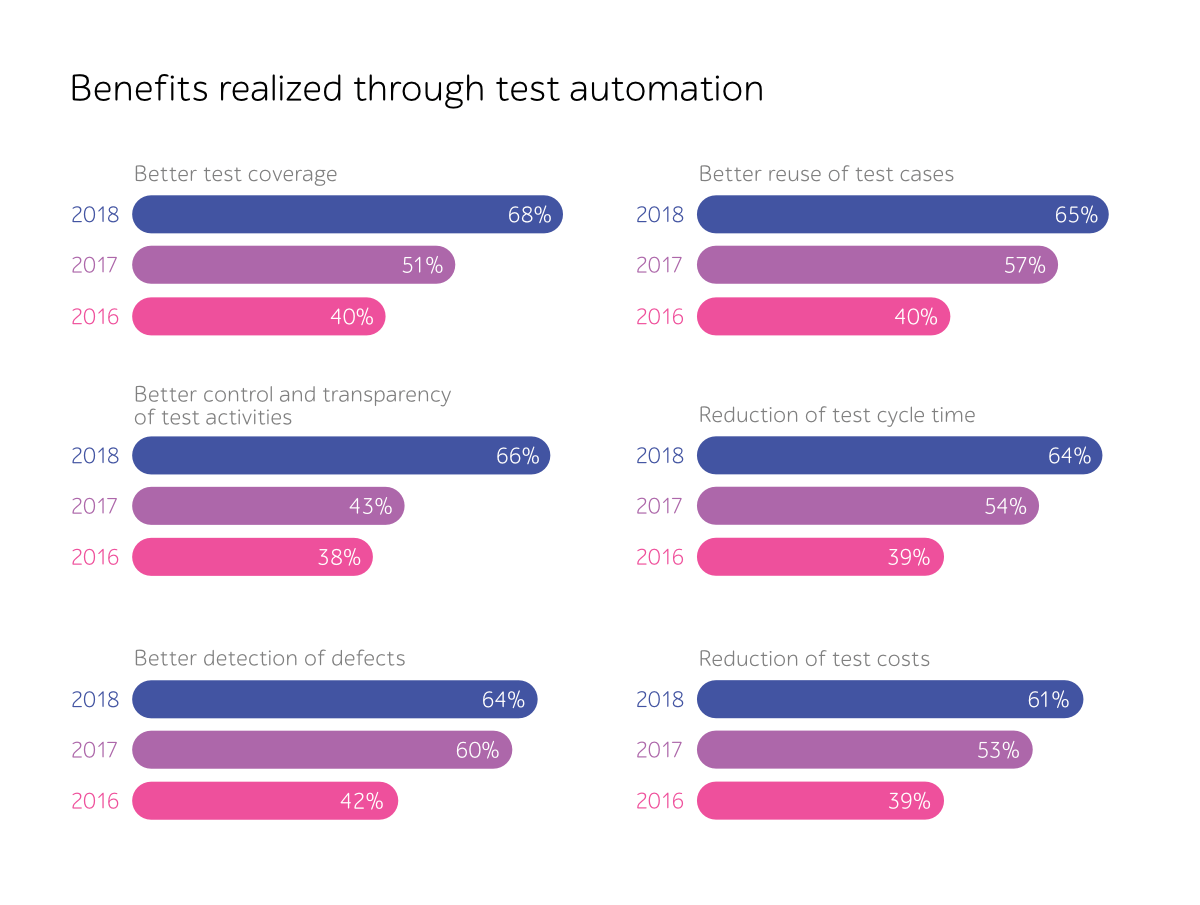
Making test automation a reality: part 2
In this blog post, we want to continue the conversation about the main aspects of the test automation service. Let us move on discussing how AI can help make automation more effective and address the common myths alongside with the business benefits one can expect at the end of this journey.
Common test automation misconceptions
Many people consider the automation of tests as some separate area of knowledge not related to testing at all.
Performing automation with wrong assumptions can provide poor software results. This, in turn, can lead to more misconceptions. So let’s address some best-known myths to be able to distinguish the truth and lies.
- Test automation is always more efficient than manual testing.
In fact, there’s no winner in the automation vs. manual testing debate. Each technique has its own pros and cons.
Manual testing plays an important role especially at the initial stage of development when automation cannot yet be achieved due to partial project implementation. On the other hand, when you need to conduct testing very swiftly (hotfix checks), manual testing can also take a leading part because automation cannot be achieved in a too short period.
Alternatively, if the requirements are constantly changing, it is also difficult to implement or apply automation to all requirements – this is where manual testing re-emerges as a major actor of this testing play.
In the end, both test automation and manual testing can co-exist, especially if it’s unsustainable to rely just on manual testing (for instance, when working with a huge amount of data, the human factor should be eliminated).
- Automation completely replaces human interaction.
Manual testing is best suited for tests where you need a person’s opinion, like usability tests and exploratory checks. Automation is better applicable to repeated tests, tests with a large amount of data, or tests that need to be run very often (for example, regression tests). Automated testing allows you to reduce the cost of manual testing, but only to a certain extent, by automating tasks that were mentioned earlier.
In any case, the automation solution demands regular support and a well-considered approach. Manual testing requires such skills as knowledge, experience, logical and analytical skills, creativity and other aspects that can be covered only by a human, not a machine. These skills cannot be replaced by automation.
- With automation, it’s possible to achieve full test coverage.
Yes, by means of thorough testing, QA engineers can improve test coverage. Nevertheless, due to the changing requirements (and it’s a normal thing!), there is no such a practical way to get this goal done.
Instead of aiming at reaching 100% coverage, it’s better to pay more attention to the most critical areas of functionality and conduct automation more wisely. Sometimes one can spend a lot of money on automating what doesn’t make sense to automate at all, so the most intelligent approach is highly appreciated.
- Test automation can help catch all bugs.
Automation scripts check what they’re programmed to check. All tests can be successful, still, some defects will remain unnoticed, which may give a false impression on the quality of the product itself. That said, automation can prove the presence of a defect, but cannot prove its absence instead.
Also, as it was mentioned in the previous part of the article, after adding new functionality to the existing one, automated tests can help make sure that the current functionality hasn’t broken (and provide these results very quickly). However, the number of regression defects is a little less, than the number of defects found in newly developed functionality.
As it was stated in the WQR 2018-2019, bringing together AI, ML, and analytics and their active use in conducting smarter automation will change QA and testing in the coming years.
With this in mind, let us discuss how one of the main QA trends to follow in 2019 – artificial intelligence – is shaking the test automation process.
Effect of AI on test automation
In the most general, artificial intelligence is a technology that replicates human-style intelligence processes by means of computer systems. This terminology is known as one of the hottest buzzwords in the software sphere (maybe after Agile and DevOps).
True AI empowers the QA teams to be more productive, as their focus is shifted away from repeatable tasks toward creativity and innovation.
How does AI can drive automated testing?
Without a shred of modesty, it is changing all main aspects of automation by enhancing
- Creation of tests (making this process fully autonomous using AI technologies).
AI automatically locates and identifies hundreds of selectors, analyzes the DOM state, provides page object recognition, and more.
- Test execution (even complex tests can take minutes to execute from everywhere around the Earth, from any device, with any bandwidth, and in all types of environments)
- Maintenance (AI can help by the means of self-correct/-healing tests, computer vision diagnosis, and others).
AI-powered testing also transforms businesses resulting in creating more stable suits, releasing software faster to meet end-user demands, and greater product outcomes.
When we bring AI technology and test automation together, the testing capabilities become infinitely larger. According to the WQR, 45% of respondents use AI for intelligent automation in testing.
The survey points out that one of the keys to making test automation more effective is to implement AI in automation. The engineers need to decide what to automate, what not to automate, what to automate first relying on principles of smart test automation. This is where the smartness or the use of predictive analytics re-emerge.
There is also an increasing focus on intelligent automation, which is expected to accelerate speed-to-market and eliminate human errors.
Possible business benefits
Involved right, test automation can bring back large amounts of effort and time invested. Nevertheless, business benefits are not limited by these advantages.
The WQR showed that the respondents give a higher weighting to test automation comparing with the previous years. They have highlighted the following advantages:

Summing up
Test automation goes a long way toward helping ensure a high standard of quality at all points of development and QA processes.
The trends in this sphere-like predictive analytics, RPA, are changing rapidly, and we believe automated testing to become smarter and even more popular.
Creating a successful test automation strategy and adopting this service properly can help take full advantages of test automation potential and change your business to the best.
Request a free consultation with the a1qa engineers and find out if you need to increase the focus on test automation to solve quality challenges.








